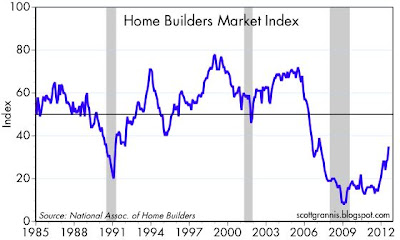Many observers of the housing market keep insisting that we have yet to see the bottom, arguing that 1) there is still a ton of foreclosed homes in banks' inventories, 2) there are still millions of delinquent mortgages, many of which will likely end up being foreclosed, 3) it is still difficult for buyers to qualify for financing, 4) unemployment is still very high, 5) consumer confidence is still low, and 5) the Fed is artificially propping up the market by depressing the Treasury yields that drive mortgage rates.
I am not arguing that these facts are untrue; the housing market is still very clearly depressed. But I do think the evidence of improvement is becoming quite clear. In the past year we have passed an important inflection point in the housing market: instead of deteriorating further, conditions are now improving on the margin, even though they are still far from being healthy.
This chart shows the results of the NAHB/Wells Fargo monthly survey of home builders' perceptions of current single-family home sales and sales expectations for the next six months. The survey also asks them to rate the traffic of prospective buyers, and then seasonally adjusts the results. A reading of 50 indicates that more builders view conditions as good than poor. So the July reading of 35, which significantly beat expectations of 30, indicates that conditions are still far from "good," but definitely getting less "poor." This is a very important and positive change on the margin, even if overall conditions are still not very good.
This chart shows an index of the price of major homebuilders' stocks. It is up 68% from last year's low, and up 166% from its 2009 recession low. The market, always forward-looking, says we saw the worst of the housing market a long time ago, and is confirming the view that conditions in the housing market, while still depressed, are improving on the margin.
Meanwhile, the Radar Logic measure of home prices, which reflects the average cost per square foot of homes sold in 25 metropolitan areas with a 63-day lag, now shows that prices on May 15th were unchanged from a year ago. Before prices start rising, they have to stop falling.









3 comments:
Housing is growing slowly and industrial production is growing along with capacity utilization. But a lot indicators show a slowing of the economy. A lot of people say the economy is slowing down to a stall speed. These discrepancies are why I abandoned investing and went to trading. I can’t get a confidence in the macro picture.
An interesting subject to explore is banking duration and collateral mis-match. I think government borrowing has a vicious duration mismatch as the government doesn’t “lend/invest” for 10 years or 30, it does so for infinity since the government never intends to get repaid for their “lending/investing” and thus never intends to repay their liability. Government collateral mis-match is with a vengeance as most of what government spends on is consumption, regardless that the government supremeists call it investment.
Correct on all counts, Squire. The lack of interest (no pun intended) in repaying any liability is evidenced by the likes of Krugman, et al, speaking of only the payment of interest on the debt. By that measure government should maximize liabilities to the extent that it can meet interest payments exactly. Fully saturated our economy with debt. But then, of course, they say, the idea is pull back the debt and deficit spending during expansion, and around and around we go. The whole model being based on trust of politicians to be responsible and actually shrink the debt when the economy is expanding. The whole model by my estimation is basically crap. We are indeed living in interesting times.
Annotatily, my rather high end condominium development in Richmond, VA has started to build 3 new town-homes and 2 four story condominium buildings with 13 units each after not doing anything for 3 years.
Post a Comment